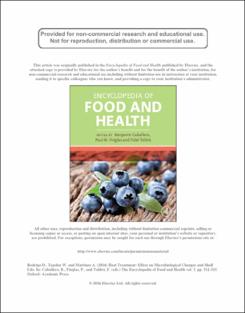Mostrar el registro sencillo del ítem
Heat Treatment: Effect on Microbiological Changes and Shelf Life
| dc.contributor.author | Tejedor, Wesley | |
| dc.date.accessioned | 2017-11-01T21:23:57Z | |
| dc.date.accessioned | 2017-11-01T21:23:57Z | |
| dc.date.available | 2017-11-01T21:23:57Z | |
| dc.date.available | 2017-11-01T21:23:57Z | |
| dc.date.issued | 2016-01-01 | |
| dc.date.issued | 2016-01-01 | |
| dc.identifier.uri | http://ridda2.utp.ac.pa/handle/123456789/2930 | |
| dc.identifier.uri | http://ridda2.utp.ac.pa/handle/123456789/2930 | |
| dc.description | Foods are complex ecosystems constituted by the environment and the microorganisms that live in it. The food environment consists of intrinsic factors such as pH, water activity, and nutritional components and extrinsic factors such as temperature and gaseous composition, among others. By manipulating these, factors microbial growth can be limited and enzymatic degradation can be avoided, achieving the food preservation. Thermal treatment is one of the most important physical methods for increasing the shelf life of foods. It is a versatile and economical system that can be adapted to almost any foodstuff and package. It can also be combined with other physical or chemical stress factors to achieve the microbiological stability of foods, causing the least possible destruction of quality. Traditionally, foods have been sterilized in hermetically sealed tinplate cans or glass jars. The intensity of the heat treatment applied depends on the type of foodstuff, quality of raw materials employed, pH, transportation and storage conditions, and geographic retail area. If the treatment complies with ‘commercial sterilization’ standards and no recontamination is allowed, it is clear that foods preserved by sterilization are stable and safe from a microbiological point of view during their shelf life. To avoid recontamination, sterilization relies on the existence of a hermetic package and, in some cases, such as with aseptic packaging, on very strict additional hygiene measures. | |
| dc.description.abstract | Foods are complex ecosystems constituted by the environment and the microorganisms that live in it. The food environment consists of intrinsic factors such as pH, water activity, and nutritional components and extrinsic factors such as temperature and gaseous composition, among others. By manipulating these, factors microbial growth can be limited and enzymatic degradation can be avoided, achieving the food preservation. Thermal treatment is one of the most important physical methods for increasing the shelf life of foods. It is a versatile and economical system that can be adapted to almost any foodstuff and package. It can also be combined with other physical or chemical stress factors to achieve the microbiological stability of foods, causing the least possible destruction of quality. Traditionally, foods have been sterilized in hermetically sealed tinplate cans or glass jars. The intensity of the heat treatment applied depends on the type of foodstuff, quality of raw materials employed, pH, transportation and storage conditions, and geographic retail area. If the treatment complies with ‘commercial sterilization’ standards and no recontamination is allowed, it is clear that foods preserved by sterilization are stable and safe from a microbiological point of view during their shelf life. To avoid recontamination, sterilization relies on the existence of a hermetic package and, in some cases, such as with aseptic packaging, on very strict additional hygiene measures. | en_US |
| dc.language | eng | |
| dc.language.iso | eng | en_US |
| dc.rights | https://creativecommons.org/licenses/by-nc-sa/4.0/ | |
| dc.rights | info:eu-repo/semantics/openAccess | |
| dc.subject | Heat Treatment | en_US |
| dc.subject | Microbiological | en_US |
| dc.subject | Shelf Life | en_US |
| dc.subject | Heat Treatment | |
| dc.subject | Microbiological | |
| dc.subject | Shelf Life | |
| dc.title | Heat Treatment: Effect on Microbiological Changes and Shelf Life | en_US |
| dc.type | info:eu-repo/semantics/article | |
| dc.type | info:eu-repo/semantics/publishedVersion |
